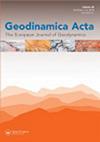Linking the NE Anatolian and Lesser Caucasus ophiolites: evidence for large-scale obduction of oceanic crust and implications for the formation of the Lesser Caucasus-Pontides Arc
IF 1.5
Q1 Earth and Planetary Sciences
引用次数: 63
Abstract
In the Lesser Caucasus and NE Anatolia, three domains are distinguished from south to north: (1) Gondwanian-derived continental terranes represented by the South Armenian Block (SAB) and the Tauride–Anatolide Platform (TAP), (2) scattered outcrops of Mesozoic ophiolites, obducted during the Upper Cretaceous times, marking the northern Neotethys suture, and (3) the Eurasian plate, represented by the Eastern Pontides and the Somkheto-Karabagh Arc. At several locations along the northern Neotethyan suture, slivers of preserved unmetamorphozed relics of now-disappeared Northern Neotethys oceanic domain (ophiolite bodies) are obducted over the northern edge of the passive SAB and TAP margins to the south. There is evidence for thrusting of the suture zone ophiolites towards the north; however, we ascribe this to retro-thrusting and accretion onto the active Eurasian margin during the latter stages of obduction. Geodynamic reconstructions of the Lesser Caucasus feature two north dipping subduction zones: (1) one under the Eurasian margin and (2) farther south, an intra-oceanic subduction leading to ophiolite emplacement above the northern margin of SAB. We extend our model for the Lesser Caucasus to NE Anatolia by proposing that the ophiolites of these zones originate from the same oceanic domain, emplaced during a common obduction event. This would correspond to the obduction of non-metamorphic oceanic domain along a lateral distance of more than 500 km and overthrust up to 80 km of passive continental margin. We infer that the missing volcanic arc, formed above the intra-oceanic subduction, was dragged under the obducting ophiolite through scaling by faulting and tectonic erosion. In this scenario part of the blueschists of Stepanavan, the garnet amphibolites of Amasia and the metamorphic arc complex of Erzincan correspond to this missing volcanic arc. Distal outcrops of this exceptional object were preserved from latter collision, concentrated along the suture zones.连接东北安纳托利亚和小高加索蛇绿岩:海洋地壳大规模逆冲的证据和对小高加索-庞德斯弧形成的启示
在小高加索和东北安纳托利亚,从南到北可划分出三个域:(1)以南亚美尼亚地块(SAB)和Tauride-Anatolide台地(TAP)为代表的冈瓦尼亚衍生大陆地体;(2)中生代蛇绿岩的零散出露,在上白垩世期间被逆冲,标志着北新特提斯缝带;(3)欧亚板块,以东Pontides和Somkheto-Karabagh弧为代表。在新特提斯北部缝合带上的几个位置,保存下来的现已消失的新特提斯北部大洋域的未变质遗迹(蛇绿岩体)在被动的SAB和TAP边缘的北部边缘向南倒转。缝合带蛇绿岩向北逆冲;然而,我们认为这是在逆冲活动的欧亚边缘后期的逆冲和增生。小高加索的地球动力学重建显示了两个北倾俯冲带:(1)在欧亚边缘下,(2)在更南边,一个洋内俯冲带导致蛇绿岩侵位在南高加索北缘之上。我们将小高加索的模型扩展到东北安纳托利亚,提出这些区域的蛇绿岩起源于同一个洋域,在一个共同的逆冲事件中放置。这对应于非变质洋域沿500多公里的横向逆冲和80公里的被动大陆边缘逆冲。我们推断,在洋内俯冲之上形成的消失的火山弧,是通过断裂和构造侵蚀的结皮作用被拖到倒转蛇绿岩之下的。在这种情况下,斯捷潘纳万的部分蓝片岩、阿玛西亚的石榴石角闪岩和额尔锌干的变质弧杂岩对应于这个缺失的火山弧。这一特殊物体的远端露头从后来的碰撞中保存下来,集中在缝合带。
本文章由计算机程序翻译,如有差异,请以英文原文为准。
求助全文
约1分钟内获得全文
求助全文
来源期刊

Geodinamica Acta
地学-地球科学综合
CiteScore
4.50
自引率
0.00%
发文量
0
审稿时长
25 weeks
期刊介绍:
Geodinamica Acta provides an international and interdisciplinary forum for the publication of results of recent research dealing with both internal and external geodynamics. Its aims to promote discussion between the various disciplines that work on the dynamics of the lithosphere and hydrosphere. There are no constraints over themes, provided the main thrust of the paper relates to Earth''s internal and external geodynamics. The Journal encourages the submission of papers in all fields of earth sciences, such as biostratigraphy, geochemistry, geochronology and thermochronology, geohazards and their societal impacts, geomorphology, geophysics, glaciology, igneous and metamorphic petrology, magmatism, marine geology, metamorphism, mineral-deposits and energy resources, mineralogy, orogeny, palaeoclimatology, palaeoecology, paleoceanograpgy, palaeontology, petroleum geology, sedimentology, seismology and earthquakes, stratigraphy, structural geology, surface processes, tectonics (neoteoctonic, plate tectonics, seismo-tectonics, Active tectonics) and volcanism.
Geodinamica Acta publishes high quality, peer-reviewed original and timely scientific papers, comprehensive review articles on hot topics of current interest, rapid communications relating to a significant advance in the earth sciences with broad interest, and discussions of papers that have already appeared in recent issues of the journal. Book reviews are also included. Submitted papers must have international appeal and regional implications; they should present work that would be of interest to many different specialists. Geographic coverage is global and work on any part of the world is considered. The Journal also publishes thematic sets of papers on topical aspects of earth sciences or special issues of selected papers from conferences.
 求助内容:
求助内容: 应助结果提醒方式:
应助结果提醒方式:


